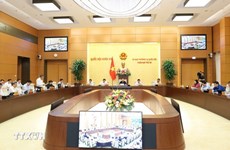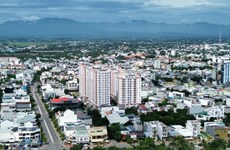North-South high-speed railway: Which option is effective, feasible?
 High-speed railway line of Japan (Photo:Vietnam +)
High-speed railway line of Japan (Photo:Vietnam +)
Hanoi (VNA) - Regarding the selection of plan to invest in the North-South high-speed railway project, which has been rising recently, Professor and Doctor of Science La Ngoc Khue, former Deputy Transport Minister, said that the scenario of a 350km/h high-speed railway proposed by the Ministry of Transport is lacking the feasibility of investment capital and efficient operation when only carrying passengers but goods.
Mr. Khue also worries that foreign countries will easily manipulate and monopolize the life cycle of the North-South high-speed railway and admits that the trend of high-speed railway with the operating speed from 160 to 200km /h is favoured and selected by many countries in the world.
VietnamPlus correspondent had a discussion with Mr. La Ngoc Khue about this issue.
Lack of feasibility, fear of foreigners’ monopoly
- The North-South high-speed railway project has a huge difference in total investment (US $ 32 billion) and the speed of operation of 200km/ h or 350km/ h between the Ministry of Transport and the Ministry of Planning and Investment. What is your view on this issue?
Mr. La Ngoc Khue: The Prime Minister’s Decisions have clearly stated that from now to 2030, investment in the North-South high-speed railway project is only for train operation with the speed from 160 to less than 200km/h. Speeding at 350km/h is only set after 2050.
Decision 1468/QD-TTg dated August 24, 2015 with a higher legal limitation did not mention when it was necessary to operate the 350km/h high-speed trains. In other words, a high-speed railway with a speed of 350km/h is just a story of the future.
So, on what basis does the Consulting Transport Designing Consulting Corporation (TEDI) confirm the design speed of the North-South high-speed railway is 350km/h and the operating speed is 320km /hours?
Regarding the total investment of 58.7 billion USD proposed by the Ministry of Transport, high-speed rail is difficult to ensure financial viability, which is a huge burden on the economy because it is 50 times larger than the Central Budget's total spending on transport infrastructure development for a fiscal year, as it has been throughout the years.
Therefore, high-speed trains with an operating speed of 160km to less than 200km/h and a design speed of over 200km/h allowing to transport both passengers and freight seemsto be a very reasonable choice and suitable for the reality of our country. That choice has made the project completely feasible and be able to respond quickly and best to the immediate requirements, while creating a premise for future development.
With the speed of 200km/h, the journey between Hanoi and Ho Chi Minh City and vice versa of passenger trains takes 8 hours. At a speed of 110km/h, cargo trains carrying fresh fruits and vegetables on the North-South axis last 14 hours.
- Many people think that building a high speed railway of 350km/h will lead to dependence on foreign technology, acquisition of project contracts and opportunities for Vietnamese enterprises to own and win bidding for project contracts is no longer available. What do you think about this?
Mr. La Ngoc Khue: Let’s look at the urban railway project. It shows our country's understanding is not deep enough, lackig of practicality and production experience; the monopoly is shown in project implementation contracts, the supply of materials, equipment and facilities provided by the financiers.
For a high-speed railway project, when being implemented, it will be much more serious. Both in scale and technical specifications and quality requirements, high-speed railway is at a level that urban railways can not compare.
If we are in a hurry to deploy the North-South high-speed railway project while there is almost no minimum preparation, our country will no longer have the opportunity to implement our rights and autonomy.
So the choice of operating speed level of less than 200km/h is a reasonable and suitable option, helping Vietnamese businesses to approach and master technical equipment, making the project properly implemented, creating long-term sustainable effect.
Only designing speeds from 160 to less than 200km/h
- The Ministry of Transport has proposed to diverge the project investment into 2 phases with the Hanoi-Vinh and Ho Chi Minh-Nha Trang sections to be implemented from 2020-2032. After 20 years, the high-speed rail will connect with each other (finishing the Vinh-Nha Trang sectionte). So, will it be difficult for provinces and cities in the Central region to develop in parallel and cause imbalance in transport capacity?
Mr. La Ngoc Khue: After spending nearly 60 billion USD with the time consumption of not less than 3 decades, the North-South High-Speed Railway line will be completed, bringing a major change in operating capacity. guests on the North-South axis. However, there are still shortcomings that need to be clearly seen.
Specifically, passenger capacity is redundant because 140 pairs of trains day and night is enough to transport 364,000 passengers/day, while the highest passenger density of the pre-feasibility study report of the Ministry of Transport in 2050 is 145,264 passengers/day and 155,421 passengers/day, respectively (accounting for only 40% and 43% of the approved capacity), the remaining 57-60 percent of the approved capacity has been wasted, so it can not make full use of investment efficiency.
High-speed rail is exclusively used for passenger transportation but it cannot help improve the situation of freight transport on the North-South axis, it has no effect on reducing logistics costs.
Not to mention, if it follows the proposal of the Ministry of Transport, in the next 20 years, the transport situation on over 60 percent of the remaining length of the route from Vinh to Nha Trang which is nearly 900 km is still unchanged, still based on an old, meager railway, the trips across Vietnam of low-income people are still very hard.
The situation becomes more difficult when there is a storm, the railway is swept away and paralyzed. While the capacity of high-speed train at both ends of the line is extremely redundant, it is impossible to do anything.
 Professor, Doctor of Science La Ngoc Khue, former Deputy Minister of Transport (Photo:Vietnam +)
Professor, Doctor of Science La Ngoc Khue, former Deputy Minister of Transport (Photo:Vietnam +)
- There is an opinion that it is necessary to modernize the existing railway to use for transporting goods, while the high-speed railway is exclusively used for passenger transport. What do you think about this view?
Mr. La Ngoc Khue: If we build a high-speed railway with operating speed from 160 to less than 200km/h, we can run mixed trains, both passenger trains and freight trains on it, like the North European and North American countries have been and are still doing. It means an arrow aims at two goals, meeting all the requirements being set. It is a very reasonable and right choice, it cannot be otherwise.
- Can you talk about the trend for high speed rail in the world?
Mr. La Ngoc Khue: After a few decades of high-speed railway projects, the world is facing a master adjustment.
Prime Minister Prayut Chan Ocha of Thailand requires that the speed of Thai high-speed rail project which is cooperated with Japan should be only at 180-200km/h.
According to statistics of the US Institute of Environment and Energy, only one third of more than 30 countries which already have or the policy of building high-speed railway chooses the speed at 300km/h. More than 20 other countries all choose to have a speed of only around 200km/h, including rich and developed countries such as Norway, Finland, Denmark, Sweden, Switzerland ... and even Russia and the United States also do not have railways operating at high speed.
Therefore, the North-South high-speed railway with the operation speed from 160 to 200km/h in accordance with the decisions of the Prime Minister is consistent with the general trend, ensuring a feasible and effective project and is a right choice.
- Thank you Sir./.













